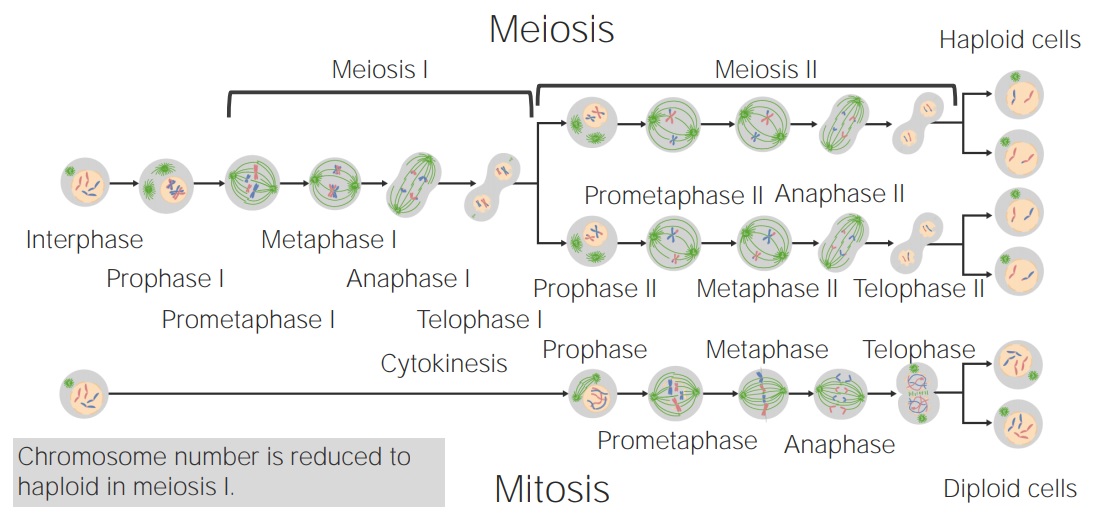Playlist
Show Playlist
Hide Playlist
Comparing Mitosis and Meiosis – Cell Division
-
Slides 13 Meiosis CellBiology.pdf
-
Reference List Molecular and Cell Biology.pdf
-
Download Lecture Overview
00:00 Wir haben nun die Mitose von der Meiose abgeleitet. Nun möchte ich Sie bitten, sich daran zu erinnern, welche Teilung die Reduktionsteilung ist. Wo wird die Zelle haploid? Das Wichtigste hier ist, ich kann es nicht oft genug betonen, dass das haploide bei der Meiose I geschieht. Behalten Sie das also im Hinterkopf. 00:27 Vergleichen wir nun kurz die Mitose mit der Meiose. Wir wissen, daß die Meiose zwei Phasen hat und die Mitose nur eine Phase. Wir wissen, dass die Meiose ähnlich wie die Mitose in Meiose II aussieht, da Schwesterchromatiden getrennt werden. Dagegen sieht Meiose I überhaupt nicht wie eine Mitose aus, da homologe Chromosomen getrennt werden. Ich meine, es sieht zwar so ähnlich aus, weil wir etwas trennen und wir alle die gleichen Spindelfasern haben und der ganze Apparat ist derselbe, aber Meiose I ist wegen der homologen Chromosomenpaarung sehr anders. Am Ende der Mitose haben wir identische Zellen. 01:13 Am Ende der Meiose jedoch, haben wir vier genetisch unterschiedliche Gameten, oder Spermien und Eizellen. Wir können also den ganzen Weg durch Meiose I durchlaufen und erst in Meiose II wird es anfangen gleich auszusehen. Viele Fragen, auf die Sie stoßen werden betreffen die Chromosomenzahl. Wie viele von ihnen befindeen sich in der Prophase? Wie viele von ihnen reihen sich auf der Metaphasenplatte auf? Visualisieren Sie diese Prozesse, vergleichen und kontrastieren Sie. Denke Sie über die Anzahl der Chromosomen nach und wie viele DNA-Moleküle sich am Ende in Meiose I und wie viele DNA-Moleküle sich am Ende der Meiose II in jeder Zelle befinden. 01:57 Und vergleichen und kontrastieren Sie diese mit dem, was während der Mitose passiert. Die entscheidende Frage ist, wer sich auf der Metaphasenplatte verbindet. 02:04 Wenn man das versteht, ist man wirklich für den Erfolg gerüstet. Also in diesem Vortrag, werden wir uns an die Sprache, die Vokabeln der Chromosomen erinnern. Und ich hoffe, Sie sehen, wie wichtig es ist, eine wirklich gutes Verständnis für die Sprache zu haben. Und zusätzlich Darüber hinaus haben wir begonnen, Merkmale der Meiose zu unterscheiden. Eines davon war die genetische Rekombination. Wir haben weiterhin die Paarung von Homologen und Synapsen. Wir haben Überkreuzungen und Austausch von genetischer Information. Wir haben auch Anordnungen der Chromosomen auf der Metaphasenplatte. Diese ist zufällig. Wir bringen also während der Meiose alles durcheinander. 02:44 Wir sollten auch in der Lage sein, zusammenzufassen, wie genetische Variation während der Meiose stattfindet und auch wie die Meiose mit der Gametenbildung im Zusammenhang steht. 02:57 Wie spiegelt sich also die Meiose im weiblichen Fortpflanzungssystem im Vergleich zum männlichen Fortpflanzungssystem wider. 03:02 Und schließlich, ist es eine gute Idee, diese drei Ereignisse zu vergleichen und zwischen Mitose versus Meiose I und Meiose II zu unterscheiden. Also, hoffentlich hat diese Vorlesung einige Details über die Vorgänge während der Meiose und warum die Meiose für die sexuelle Fortpflanzung wichtig ist, geklärt. 03:28 Herzlichen Dank! Ich freue mich darauf Sie in einem zukünftigen Vortrag zu sehen.
About the Lecture
The lecture Comparing Mitosis and Meiosis – Cell Division by Georgina Cornwall, PhD is from the course Cell Cycle and Cell Division.
Included Quiz Questions
During which of the phase do sister chromatids move to the opposite poles of a cell?
- Anaphase II
- Anaphase I
- Metaphase I
- Cytokinesis
- Prophase I
How many chromosomes are present in daughter cells at the end of mitosis, meiosis I, and meiosis II, respectively?
- 46, 23, 23
- 23, 23, 46
- 92, 46, 46
- 46, 46, 23
- 92, 92, 46
Customer reviews
3,7 of 5 stars
| 5 Stars |
|
2 |
| 4 Stars |
|
0 |
| 3 Stars |
|
0 |
| 2 Stars |
|
0 |
| 1 Star |
|
1 |
Everything is confusing. The diagrams and what she was saying didnt allign. ALso she never gave the answer to the number of chromosomes in each stage of meiosis and mitosis
Concise and to the point for basic understandment of the subject.
Dr. Cornwall is very thorough and paces herself very well in relating core concepts.




